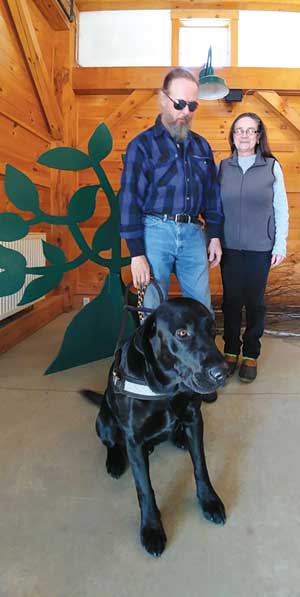 |
|
Ron and Melissa Harwood and Luke. Photo by Michele McCarthy |
By Ellen S. Gibson
Maine AgrAbility staff attends various events throughout the year to further its mission to help farmers, members of farm families and farm workers overcome pain, injury or disability so that they can continue to work safely and productively. In late September we are in the Ag Demo Tent at the Common Ground Fair. That’s where we first met Ron Harwood, who stopped by our booth with his beautiful black lab service dog, Luke. Luke is one of the few dogs allowed at the fair, because he helps Ron keep track of where he is going.
Ron has advanced glaucoma, a progressive disease that has stolen his eyesight since 2010. Legally blind since 2012, he can now see only a few shadows in his peripheral vision. Ron is a “maker,” a thinker, a tinkerer and an engineer with an inquisitive nature. His vision impairment has only increased his need for inventiveness. He is happiest putting his ideas to practical use in his garden, a place of continual learning for him. Now that he has retired from a varied engineering career, including management positions with Maine Fence Company, Cianbro and Maine Woods Pellet, Ron and his wife, Melissa, often travel to events at MOFGA. His goal is to conceive, develop and promote low-tech equipment and techniques to benefit small farmers. As he puts it, “I don’t need eyesight to have vision.”
The Harwoods farm in Harmony, 20 miles north of Skowhegan. Melissa’s family goes back four generations there. As a child she spent summers with her grandparents at Maple Lawn Farm. The farm later transitioned to Melissa’s parents, and now to Ron and Melissa, who care for the 90 acres of woodlands and pasture. They grow a variety of crops, raise a few animals and put up hay to sell. They are part of the local Transition Towns movement, creating community resiliency in the face of changes as the world transitions from fossil fuels to alternative forms of energy.
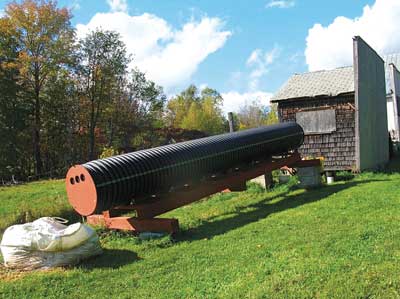 |
|
This tubular composter, 2 feet in diameter and 20 feet long, is set at an angle so that gravity moves organic matter from the upper to the lower end. The Harwoods compost all their organic waste, with a goal of having finished compost in three weeks. Photo by Ellen Gibson |
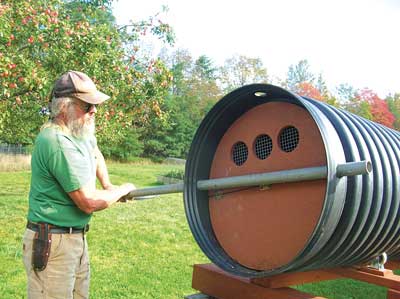 |
|
Ron turns the composter once a day using a simple lever to mix materials thoroughly and speed decomposition. Photo by Ellen Gibson |
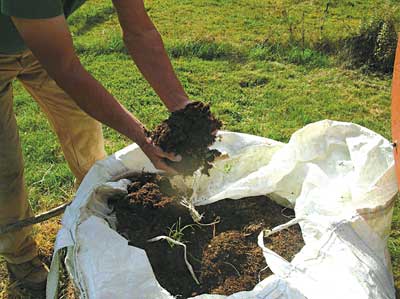 |
|
Finished compost is discharged into a repurposed 1-ton grain bag. Photo by Ellen Gibson |
Learning All the Time
Ron has been working on a gravity-fed tubular composter for a couple of years. The composting tube is a repurposed 20-foot-long culvert made of black polyethylene. The material is smooth on the inside and ribbed on the outside. Oriented to the south, the tube is on rollers and is secured to a slanted foundation. It can be turned easily, which mixes the compost. As it decomposes, the material moves down the tube. Ron aims for an internal temperature of 140 to 150 F. He monitors this carefully because too much heat will kill the bacteria that do the composting.
He is proving the concept with his prototype while continually improving the design. He plans to add paddles inside the tube to mix the waste more thoroughly and speed decomposition. His goal is to harvest finished compost in three weeks.
Ron composts all the organic waste he and Melissa generate – about three 5-gallon buckets per day from the kitchen, gardens and animal manures. He can make compost from April or May (when he first mows the grass) into December. “It’s all an experiment,” he says. “I don’t learn as much from success as I do from failure.”
Where Does All the Compost Go?
The Harwoods raise a number of crops in 200 recycled 5-gallon plastic buckets, which they fill with a mixture of half compost and half topsoil. The “bucket garden” is laid out in eight rows of 25 buckets. The organization and layout work well for someone who is blind or visually impaired. Last year he grew 55 buckets of black beans as well as Swiss chard, carrots, onions and potatoes. One potato plant per bucket yields 2 pounds of potatoes. Besides a good yield, Ron has found another reason to grow potatoes in buckets: no potato beetles.
“The beetles have to walk up the bucket to reach their first meal,” he says, “and they can’t reach the plants because of the slippery plastic.” Flying pests are still a nuisance, but row covers help. Melissa picks Japanese beetles by hand, and they plan to experiment with companion planting this coming season.
Container gardens require frequent watering, and although watering by hand is simple, it can be time consuming. Next year Ron plans to install a drip irrigation system with rated emitters and manual timers for different bucket crops. Commercially available drip lines have emitters every 12 inches and emit 1 gallon per bucket per hour, so regulating water use can be accurate.
Another section of the garden is devoted to crops planted in rows of tires spaced 6 feet center to center, 100 in all. The tire spacing enables Ron to mow between the hills without running over the crops. Each tire is filled with a 50/50 soil and compost mixture. Over the past three years, he’s had success growing Kabocha squash, Double Red sweet corn and black beans in tires. Cucumbers, not so much! With the tires, he can avoid tillage and simulate elevated soil temperatures. (Certified organic growers should check with their certifier before raising crops in tires.)
Grass mowed from this area is composted or turned into a nitrogen wash. To make the wash, Ron fills a 5-gallon bucket with fresh grass clippings, then fills the pail with water. After letting the mixture “cook” for a few days in the sun, he uses the grass to mulch his strawberries and pours the water on crops needing a nitrogen boost.
Horseradish and rhubarb grow in another area – both easy crops for visually challenged gardeners.
Ron and Melissa grow Kentucky Wonder and Rattlesnake pole beans along a 100-foot wire trellis. They harvest green beans until they become stringy, then leave them to mature and dry on the vine for baking or seed. Each year they harvest about 40 pounds of dry beans. “Plucking” the trellis wires helps Ron locate the dried pods audibly. He marvels at the proliferation of seeds: “One bean seed will yield a harvest of 130 seeds on average. Our Kentucky Wonder and Rattlesnake beans yield about 40 pounds of dry beans each year. That would be 13,000 linear feet [that we could plant] if we didn’t eat them. That’s the magic for us.”
They save and package their seeds. “We sell nothing. We either eat it or give the seed packs away, to friends, neighbors, charitable organizations or churches.”
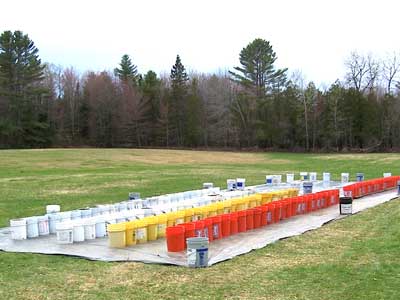 |
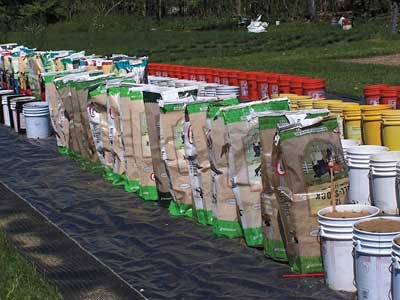 |
| A container garden laid out in rows with one type of plant per bucket is ideal for blind or visually impaired gardeners. | Repurposed grain bags fit perfectly over buckets to provide frost protection. Photos by Ron Harwood |
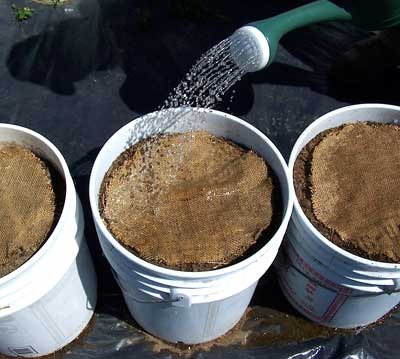 |
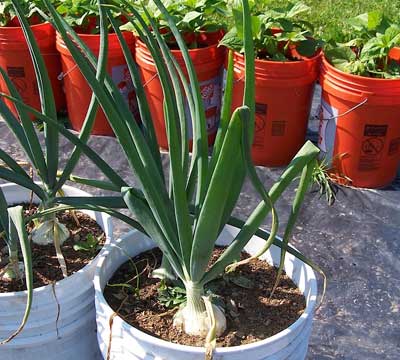 |
|
Ron uses burlap sponges to keep carrot seeds moist and undisturbed during germination. Photo by Ron Harwood |
Onions and beans growing in containers. Photo by Melissa Harwood |
Despite the quality and quantity of food he raises, Ron says, “I’m a neophyte at gardening.” He was influenced by “A Nation of Farmers: Defeating the food crisis on American soil,” a book that proposes local solutions to global food problems. He also enjoyed the movie “Seed.” His agricultural hero is Will Bonsall. “I’d love to have him come see what we’re doing here.”
Indeed, at Maple Lawn Farm ideas take root like seeds, and discoveries are around every corner. A few years ago, in late summer, Melissa discovered on the property an apple tree she’d never noticed before. It was fully mature and covered with large, flavorful apples. John Bunker came to look at it, declaring it was a variety he hadn’t seen before. To honor its location, the tree has been named the “45th Parallel Apple Tree.” It just goes to show that the richness of the natural world contains much more than meets the eye.
Watch for Maine AgrAbility at Farm & Homestead Day at MOFGA on June 23, 2018, when the Harwoods will join us at the raised garden beds. They will discuss the specifics of a bucket garden: How to clean buckets if they were previously used to store oil; using grain sacks for thermal insulation; size and position of drainage holes; burlap “sponges” as seed incubators. We’ll have clay pots that children can paint and seedlings they can plant. We’ll also renovate the soil in last years’ beds and plant new crops. Maine AgrAbility staff will bring examples of ergonomic tools and provide tips on gardening mindfully to avoid pain and discomfort. See you then!
AgrAbility Assessment
Early in 2016, AgrAbility staff met the Harwoods on their farm for a kitchen table interview and a tour of the farm. Their priorities are to raise a sustainable hay crop without using synthetic chemicals and to keep the farm property protected in perpetuity. Other long-term goals include ideas for expanded enterprises:
• Develop a sugar bush for maple syrup
• Grow organic grapes for organic raisins
• Pursue a high tunnel or greenhouse for container growing or raised beds
• Increase poultry for dual purpose use
To support Ron as he develops the tubular composter, Maine AgrAbility suggested the Maine Compost School at the University of Maine and USDA Sustainable Agriculture Research and Education (SARE) grants. Other suggestions included smartphone and iPad apps for animal identification and care. (Are all the chickens in?) Because cell phone coverage in their area is spotty, Ron and Melissa find the older technology –portable radios for communication, emergencies and weather alerts – suit their needs well.
About the author: Ellen Gibson is on staff at Maine AgrAbility. She owns and manages Stearns Hill Farm in West Paris, where she is restoring the 19th century working barn. She raises Nubian goats on the fields and browse using Holistic Management practices.
